
The European Union (EU) has expanded a number of times throughout its history by way of the accession of new member states to the Union. To join the EU, a state needs to fulfil economic and political conditions called the Copenhagen criteria, which require a stable democratic government that respects the rule of law, and its corresponding freedoms and institutions. According to the Maastricht Treaty, each current member state and the European Parliament must agree to any enlargement. The process of enlargement is sometimes referred to as European integration. This term is also used to refer to the intensification of co-operation between EU member states as national governments allow for the gradual harmonisation of national laws.

Paris Nanterre University, formerly Paris-X and commonly referred to as Nanterre, is a public research university based in Nanterre, Paris, France. It is one of the most prestigious French universities, mainly in the areas of law, humanities, political science, social and natural sciences and economics. It is one of the thirteen successor universities of the University of Paris. The university is located in the western suburb of Nanterre, in La Défense area, the business district of Paris.
A Treaty of Accession to the European Union is an intergovernmental treaty of the European Union that specifies the terms under which an applicant state becomes a member of the European Union. It represents the fundamental act to enable a state to become a member of the EU, thereby binding it to the fundamental principles of the union. In addition to the Treaty of Accession, a Final Act of Accession is signed. The Final Act registers the results of the accession negotiations, including declarations made by the parties. It also lays down arrangements for the period between signing and entry into force of the treaty.
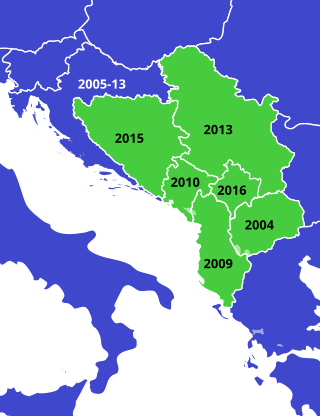
In talks with countries that have expressed a wish to join the European Union, the EU typically concludes Association Agreements in exchange for commitments to political, economic, trade, or human rights reform in that country. In exchange, the country may be offered tariff-free access to some or all EU markets, and financial or technical assistance.
The CARDS programme, of Community Assistance for Reconstruction, Development and Stabilisation, is the EU's main instrument of financial assistance to the Western Balkans, covering specifically the countries of Croatia, Bosnia and Herzegovina, Serbia, Montenegro, North Macedonia, Kosovo and Albania. It was created in 2000 by Council Regulation 2666/2000. However it was only in 2001 that the programme became operative under its own regulations, as in the first period it supported projects previously funded by the PHARE and OBNOVA programmes. The programme is the main financial instrument of EU's Stabilisation and Association process (SAp). A total of €5.13 billion is secured for all CARDS actions during 2000-2006, as after that day it will be replaced by the Instrument for Pre-Accession Assistance (IPA), which will cover both candidate and potential candidate countries.

The Commissioner for Neighbourhood and Enlargement is the member of the European Commission in charge of overseeing the accession process of prospective new member states and relations with those bordering the European Union (EU). The present Commissioner, as of December 2019, is Olivér Várhelyi.

Albania is on the current agenda for future enlargement of the European Union (EU). It applied for EU membership on 28 April 2009, and has since June 2014 been an official candidate for accession. The Council of the European Union decided in March 2020 to open accession negotiations with Albania.
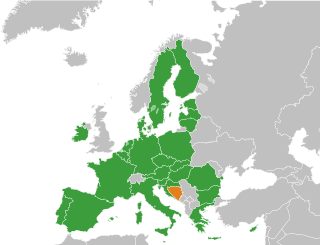
The accession of Bosnia and Herzegovina to the European Union (EU) is the stated aim of the present relations between the two entities. Bosnia and Herzegovina has been recognised by the European Union as a "candidate country" for accession since the decision of the European Council in 2022 and is on the current agenda for future enlargement of the EU. Bosnia and Herzegovina takes part in the Stabilisation and Association Process and trade relations are regulated by an Interim Agreement.
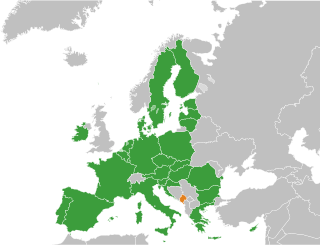
Accession of Montenegro to the European Union is on the agenda for future enlargement of the EU.
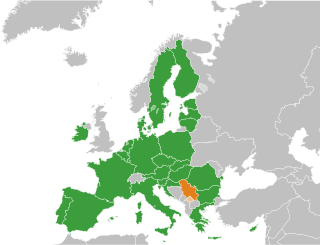
Serbia applied to join the European Union (EU) in 2009 and has been a candidate for membership since 2012, along with nine other states. Serbia is the largest country in Southeast Europe seeking entry into the EU.

The accession of Kosovo to the European Union (EU) is on the current agenda for future enlargement of the EU. Kosovo is currently recognized by the EU as a potential candidate for accession.

There are nine recognised candidates for membership of the European Union: Albania, Bosnia and Herzegovina, Georgia, Moldova, Montenegro, North Macedonia, Serbia, Turkey, and Ukraine. Kosovo formally submitted its application for membership in 2022 and is considered a potential candidate by the European Union.

The accession of North Macedonia to the European Union has been on the current agenda for future enlargement of the EU since 2005, when it became an official candidate for accession. The Republic of Macedonia submitted its membership application in 2004, thirteen years after its independence from Yugoslavia. It is one of nine current EU candidate countries, together with Albania, Bosnia and Herzegovina, Georgia, Moldova, Montenegro, Serbia, Turkey and Ukraine.

The 2012 Nobel Peace Prize was awarded to the European Union (EU) "for over six decades [having] contributed to the advancement of peace and reconciliation, democracy and human rights in Europe" by a unanimous decision of the Norwegian Nobel Committee.
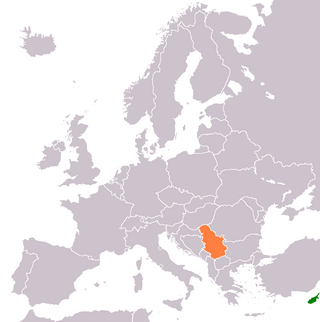
Cyprus–Serbia relations are considered as strong, due to common European policies and the sharing of Orthodoxy as a common religion. Cyprus has been a supporter of Serbia in its efforts to join the European Union. Likewise, Serbia has been advocating a stable Cyprus after the Turkish invasion in 1974 and supporting a lasting solution to the Cyprus dispute.

The Berlin Process is an intergovernmental cooperation initiative linked to the future enlargement of the European Union.

Albania and France are members of the North Atlantic Treaty Organization (NATO) and the Organization for Security and Co-operation in Europe (OSCE). Albania is an EU candidate and France is also an EU member.

The accession of Moldova to the European Union (EU) is on the current agenda for future enlargement of the EU.

András István Türke is a Hungarian historian, political scientist and diplomacy & security policy expert. He is assistant professor at the University of Szeged, where he teaches contemporary history and international relations. He is also Director of the Europa Varietas Institute where his focus is on European and African security issues. His prior teaching positions include the University of Pannonia and the National University of Public Service. He is also a member of the CÉRIUM ROP.
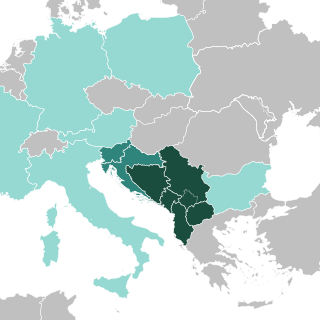
The Brdo-Brijuni Process is an annual multilateral event in the Western Balkans. It was initiated in 2013 by Slovenian president Borut Pahor and Croatian president Ivo Josipović. The first official meeting was in Brdo pri Kranju, Slovenia. The main focus of the Process is the enlargement of the European Union with countries of the Western Balkans. Similar meetings were held at the prime-ministerial level in 2010 and 2011 by then-Prime Ministers of Slovenia and Croatia, Borut Pahor and Jadranka Kosor. The Brdo-Brijuni process includes Slovenia and Croatia and candidates and potential candidates for EU membership from the Western Balkans.


















